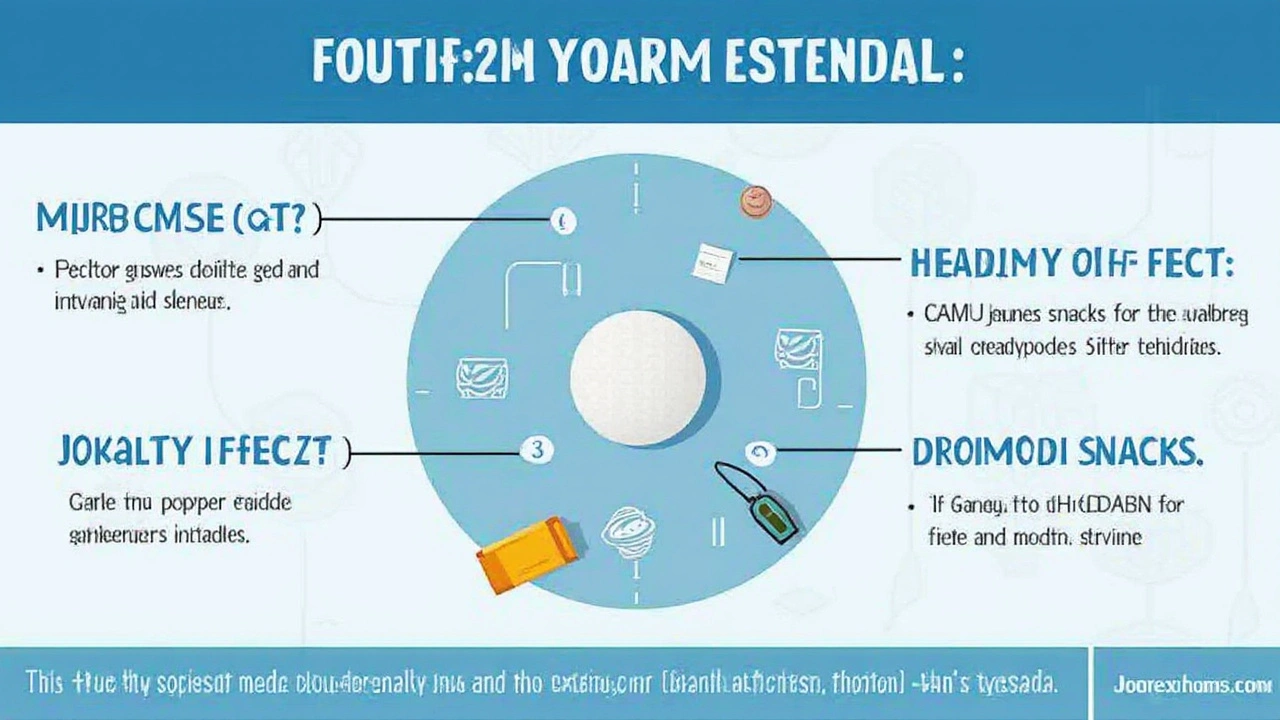Some pills really punch above their weight, and Micronase is one of them. Imagine popping a tiny tablet each morning and watching your blood sugar levels behave just a little bit better. For millions with type 2 diabetes, that's exactly what Micronase—otherwise known as glyburide—does. But here's the kicker: it's not magic. It's science, good habits, and a bit of trial and error for everyone who uses it. Thinking it's a cure-all is a common trap, and honestly, that's when problems creep up. Let's talk about how Micronase works, what you really need to know to keep your blood sugar in check, and what happens when things don't go as planned.
How Micronase Works and Why It's Still Used
Micronase, whose generic name is glyburide, lives in a family of drugs called sulfonylureas. They aren't the new kids on the diabetes block—these meds have been around since the 1950s, saving lives well before tech even figured out how to track blood sugar from your smartphone. Glyburide works by nudging your pancreas to pump out more insulin. If you think about your pancreas as a friend who sometimes forgets their keys (or, in this case, to manage your sugar), Micronase is the nudge or reminder they need. That's why it's prescribed for folks with type 2 diabetes, especially when diet and exercise alone aren't enough.
But Micronase can't fix everything. It's not for type 1 diabetics, who just don't make insulin at all, or for folks with certain liver or kidney issues. The FDA first approved Micronase back in 1984, and while newer meds now clutter pharmacy shelves, it's stayed relevant for one simple reason: it works for a lot of people, especially if price is tight. According to data out of the CDC in 2023, nearly 10% of U.S. adults had type 2 diabetes, and generic glyburide is still one of the most prescribed diabetes meds out there.
Micronase comes as a small tablet, usually 2.5 mg or 5 mg. It’s almost always taken with breakfast—timing matters, since it helps your body react to food—and sometimes a second smaller dose is needed later in the day. What shocks first-timers: it’s small but mighty. Your doctor will start you off low and ramp you up slowly because going too fast means a one-way ticket to hypoglycemia-town (that's dangerously low blood sugar).
And when you peek at your prescription, don’t be surprised if it says "Micronase (glyburide)"—pharmacies often swap in the generic, which is just as effective but usually much cheaper. Here's a quick breakdown of how it compares to similar meds:
| Drug | Drug Family | Approved For | Usual Start Dose |
|---|---|---|---|
| Micronase (Glyburide) | Sulfonylurea | Type 2 Diabetes | 2.5–5 mg daily |
| Glucotrol (Glipizide) | Sulfonylurea | Type 2 Diabetes | 5 mg daily |
| Amaryl (Glimepiride) | Sulfonylurea | Type 2 Diabetes | 1–2 mg daily |
Now the question you might really care about: does it actually work? For most, yes. A review published in "Diabetes Research and Clinical Practice" in 2022 found that glyburide drops hemoglobin A1C by about 1.5 percent on average. That's enough to shift someone from poorly controlled to right on target—big deal territory when it comes to long-term complications (think nerve damage, kidney trouble, vision loss).

Micronase Dosage, Side Effects, and Who Should Watch Out
So you’ve got that first script. Now comes the tricky part: dialing in the dose. Doctors usually start with 2.5 or 5 mg once daily, right before or with breakfast. As your blood sugar numbers come in, your doctor might tweak your dose upward, sometimes maxing out at 20 mg a day, but always divided to avoid big blood sugar swings. Stacking your dose (taking a ton at once) is a headache waiting to happen—literally and figuratively. The big risk is low blood sugar, or hypoglycemia. Forget the fancy medical words: you’ll know it if you get shaky, sweaty, confused, or just plain hangry for no good reason. It’s the #1 reason folks call their nurse hotline after starting a sulfonylurea. The American Diabetes Association reported that up to 10% of glyburide users had at least one mild hypo in their first year. If your day job means driving for hours, running machines, or working off the ground, that’s a risk you can’t ignore.
Side effects beyond that can include weight gain (since more insulin = more stored calories), upset stomach, or a rash. Still, most people tolerate Micronase without major problems. Rare but scary stuff can show up too: serious allergic reactions, or—worst case—something called hemolytic anemia (when your body attacks its own blood cells). But that’s so rare it’s almost never seen in real life unless you have certain underlying issues like G6PD deficiency.
Who shouldn't take Micronase? Pregnant women usually get switched to insulin, since oral meds might cross the placenta. Folks with kidney or severe liver problems should steer clear, since the drug is cleared by both organs and can build up if either isn’t working right. Sorry, this one isn’t for teens or kids either. And if you’re allergic to sulfa drugs, it’s time to talk to your doctor about another option.
Interactions matter too. Common culprits: beta-blockers (used for blood pressure), certain antifungals, and even booze. Drinking can make hypoglycemia sneak up on you way faster. Even skipping meals or suddenly ramping up your workout plan can force your blood sugar lower than you planned for. That’s why most docs tell you: eat regular meals, carry glucose tablets or hard candies, and never double up if you forget a dose (just pick up with the next one).
Here are a few handy tips straight from diabetes educators:
- Always take Micronase with food, ideally breakfast.
- Check your blood sugar often, especially in the first few weeks.
- Learn the signs of low blood sugar and what to do (juice box, glucose tabs).
- If you get sick, aren’t eating much, or start new meds, let your doctor know.
- Wear a medical alert bracelet if you’re on other meds that lower blood sugar.
Your dose might change if you lose weight, change your diet big-time, or rack up hours at the gym. Regular check-ins with your healthcare team are a must. Bring your own logs—otherwise, no one’s guessing what your numbers look like between visits. One hack: sync up your test times with meals and jot down what you ate. You’ll catch patterns ("Hey, every time I skip lunch, whoops—there's that shaky-legged feeling again").

Living With Micronase: Daily Life, Food Tips, and When to Ask for Help
Pills are the easy part; the rest is life. Most people who do well with Micronase learn pretty fast to think ahead. If you’re traveling, keep your meds and a snack in your carry-on (yes, flights sometimes mess up meal schedules). Kids’ sports events or wild weather that delays dinner? Always have something you can use to bump your blood sugar in a pinch—think granola bars, not just candy, so you’re not swinging from low to high like a yo-yo. One good tip: stash backup snacks and an extra pill bottle in a zipped pouch in your car that’s safe from extreme heat or cold.
Food-wise, “balanced” are the magic words. It’s not about eating bland, sad meals. Aim for a mix of carbs, healthy proteins, and fiber. That combo slows sugar spikes but still gives Micronase something to work on. People who eat high-sugar, low-protein breakfasts (think donuts, sugary cereal) run into more hypos. A good breakfast might be scrambled eggs, whole-grain toast, and a little fruit—steady energy, no drama.
Time for some myth-busting. You do not need to “eat sugar” to make Micronase work (that’s old-school thinking). But you do want to avoid fasting, juice-only cleanses, or skipping major meals. On cheat days, watch for tell-tale crashing feelings as your body and the meds wrestle each other. Alcohol can be tricky. One glass of wine? Maybe okay. Three or four? That’s gambling with your blood sugar since alcohol blunts your liver’s ability to save you from lows.
Stress and illness toss another wrench in the system. If you’re fighting a flu or running a fever, your sugar can swing unpredictably. On sick days, check your blood sugar more often and keep your doctor posted if you can’t keep food down or your numbers are wild. Diabetics on Micronase should also update that list of medications at every check-up—there’s always a chance something new could change how the drug acts in your system.
Here’s a quick-chart crash course for anyone using Micronase:
| Scenario | What To Do |
|---|---|
| Missed Dose | Take next dose as scheduled, never double up |
| Low Blood Sugar | Eat 15 grams of fast carbs (juice, glucose tab, candy) and recheck in 15 minutes |
| Start New Medicine | Ask doctor about interactions |
| Traveling | Carry snack and medication in hand luggage |
| Sick Day | Monitor sugar more often, call doctor for guidance |
When should you call for help? Any time you’re having frequent lows, unexplained highs, or you get symptoms like chest pain, fainting, or severe weakness. Don’t tough it out—that’s what the on-call doctor’s for. And if you just feel off, even if all the books say you’re in the right range, it’s okay to ask for a medication change.
Living with type 2 diabetes is a daily balancing act. Micronase is not a set-it-and-forget-it kind of pill. It works best for people who play an active role, fine-tuning when needed, and not being afraid to ask for tweaks. Most people using it today still see it as the reliable workhorse in their diabetes toolbox. Cheap, accessible, and proven—that’s why it sticks around, year after year. If you’re already on Micronase or thinking about starting, keep these tricks and facts handy. The more you know, the more control you’ll have—proving, at least this time, knowledge really is power when it comes to your blood sugar.






Andy McCullough
July 18, 2025 AT 15:53Micronase, or glyburide, works by stimulating the pancreatic beta cells to secrete more insulin, which is crucial for glycemic control in type 2 diabetes. It's important to note that this drug is generally prescribed alongside lifestyle modifications like diet and exercise to maximize efficacy.
The dosage often starts low and is titrated upwards based on blood glucose monitoring, usually beginning at 2.5 to 5 mg daily. I'd strongly recommend patients undergo regular kidney and liver function tests since impaired organ function can influence drug metabolism and increase the risk of hypoglycemia.
Speaking of hypoglycemia, it's perhaps the most significant side effect, so patient education on recognizing early symptoms is vital. Interestingly, glyburide has a longer half-life compared to other sulfonylureas, which can increase the frequency of hypoglycemic episodes if not dosed carefully.
Moreover, the drug’s interaction profile should not be ignored; for instance, concomitant use with beta-blockers may mask hypoglycemia symptoms. Hence, integrated management strategies tailored to individual patient histories are imperative.
Has anyone else here observed these nuances in clinical practice or personal experience?
Zackery Brinkley
July 24, 2025 AT 13:33Thanks for breaking that down in such detail! I’ve seen a few elderly patients struggle with managing their doses, especially because of the risk of hypoglycemia you mentioned.
It’s great to remind everyone how critical it is to balance the dosage with monitoring blood sugar closely. Sometimes people underestimate how dangerous low blood sugar can be, especially if it happens while they’re out and about.
Another thing I always suggest is making sure patients have quick sources of sugar handy in case of an episode.
What’s your take on integrating continuous glucose monitors for better control on Micronase? I think technology can really help.
Samantha Gavrin
July 25, 2025 AT 20:06I don’t know if anyone else has picked up on this, but there’s a real concern about how pharmaceutical companies push drugs like Micronase relentlessly. It seems like the risk of severe hypoglycemia is downplayed in ads, and that’s downright dangerous.
Plus, there’s always the question of whether they’re exaggerating the prevalence of diabetes to increase sales volumes. Remember, natural remedies and diet management often get overlooked because they don’t make big profits for Big Pharma.
Anyone else skeptical about the real-world use of this drug without extensive oversight?
I just worry patients aren’t fully informed about the potential side effects, or that doctors are too quick to prescribe medications instead of exploring holistic options.
NIck Brown
July 26, 2025 AT 21:06Honestly, I’ve seen way too many people get prescribed meds like Micronase without them fully understanding what they’re getting into. It’s almost like some doctors just hand them out like candy rather than emphasizing diet and exercise first.
Yeah, hypoglycemia can be deadly, and patients need to be educated properly. Plus, not everyone tolerates glyburide well, and side effects can vary a lot.
Sounds to me like we need a stronger push for patient empowerment and less blind trust in pharma companies.
What do you all think is the best way to approach that balance?
Angelina Wong
July 26, 2025 AT 21:23Great discussion here.
From a clinical perspective, glyburide is effective but demands patient compliance with dosing schedules. Patients should be advised to take it with meals to reduce the risk of hypoglycemia. Also, consistent meal timing helps maintain stable blood glucose levels.
Make sure to warn patients about symptoms of low blood sugar: sweating, tremors, confusion.
Real-world tip: carry glucose tablets or a sugary snack just in case. It’s also useful to keep a log of blood glucose readings to detect patterns and help the provider adjust dosages safely.
Proper education and communication between patient and provider are key for safe glyburide use.
Krista Evans
July 30, 2025 AT 08:43Thanks for the explanation and tips! I know managing diabetes can be super tough and scary for a lot of people.
Having someone who listens and encourages safe practices really makes a difference. Like keeping glucose handy and making sure you don’t skip meals.
Also, stressing the importance of checking in regularly with your healthcare team to avoid complications is so important.
This kind of info helps me feel less overwhelmed.
Would love to hear more about how people stay motivated to stick with these routines.
John Magnus
July 31, 2025 AT 12:30It surprises me how many people overlook the pharmacokinetics here. Glyburide’s long half-life can be a double-edged sword—it provides stable blood glucose control but also increases hypoglycemia risk during fasting or missed meals.
The mechanism involving ATP-sensitive potassium channels is well-understood, but in practice, that knowledge isn’t always translated into patient care decisions.
We need protocols that enforce screening for comorbidities before starting sulfonylureas and regular monitoring for adverse events.
Ignoring these factors is both reckless and philosophically questionable given the principle of primum non nocere.
I’m curious if newer agents with less risk should be preferred more aggressively in initial therapy.
leo dwi putra
August 1, 2025 AT 16:16Man, every time I hear 'Micronase,' I think of that wild rollercoaster of highs and lows it can cause. Like, your blood sugar's up, then down, then suddenly you’re feeling all dizzy and shaky out of nowhere. It’s like a soap opera inside your own body!
Anyone else feel like their daily routine becomes this dramatic saga where you’re constantly chasing balance, and a minor slip-up can send you into chaos? And don’t even get me started on how restrictive the diet has to be sometimes.
Incredible stuff but also kinda brutal if you ask me.
What y’all’s coping strategies? This journey is no joke.
Amanda Turnbo
August 2, 2025 AT 20:03From a critical standpoint, this post offers a good overview but seems to gloss over the fact that many patients may suffer adverse effects that are more common than advertised.
Also, the common mantra of 'use with lifestyle modifications' feels like a cop-out to me—most medical advice assumes perfect compliance, which is rarely the case in reality.
More transparency about failure rates and alternative treatments would enhance trust and decision-making.
Alexia Rozendo
August 3, 2025 AT 23:50I can’t help but chuckle at how every single thread about diabetes meds ends up sounding like a mix between a medical journal and a soap opera, and here we are again.
Seriously though, it’s kind of hilarious how much drama the body can create over a pill, like it’s the villain and the hero all at once.
Honestly, I appreciate when folks bring humor and sarcasm to lighten the weight of managing chronic illness. It reminds us that while it’s serious, we can still keep our sanity.
Mike Gilmer2
August 16, 2025 AT 17:23Well, I agree with the drama references because sometimes it feels like a medically scripted reality show inside your body. High stakes, constant suspense, a cliffhanger with every meal.
Still, I think what’s missing here sometimes is the human touch—the personal stories behind these meds, the fears, the wins, the losses.
Has anyone here had personal experience with Micronase that changed their perspective on managing diabetes?
Would love to hear more voices beyond the scientific jargon.